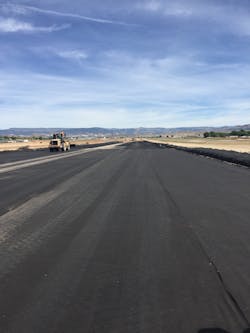Safe Air Travel Begins Beyond the Fence…and Under It
When airport infrastructure fails even in small way, the implications can be enormous. In March 2016, a landing plane cracked a runway at New York’s LaGuardia Airport and caused major flight delays. In June 2016, at London’s Gatwick Airport, flights were cancelled and delayed when a pothole opened up on one the runways. In August 2017, London’s Stansted Airport faced significant delays after a runway was closed due to a hole. At Los Angeles International Airport, a deteriorating concrete runway was the cause of an expensive lawsuit against the contractors that had rebuilt it.
It is not only the infrastructure on which a plane lands which contributes to the safety of a traveler’s airport experience though. It is also their experience of the roads, sidewalks, buildings and parking lots inside and outside the airport fence that matters. Major new airport projects – like the New International Airport of Mexico City (NAICM) and the new Salt Lake International Airport - are incorporating geogrid technology beneath the foundations of those critical structures to ensure more stable and sustainable infrastructure so that travelers have a smoother and safer experience even before they board the plane.
Geogrids are relatively rigid polymer meshes used to stabilize and improve the performance of foundation materials below roads and other types of infrastructure. Geogrid products allow transportation infrastructure organizations to decrease construction time and economically build better performing and longer lasting runways, roads, parking lots and structures. New International Airport of Mexico City provides a good example of geogrid use for soil reinforcement.
The Valley of Mexico, once covered by the waters of Lake Texcoco, is land known for containing some of the world’s softest, spongiest soil. The muddy clay ground is water logged (three particles of water for every particle of soil), saltier-than-seawater and sinking at a rate of 1.5 to two centimeters a month. The ground is rich in volcanic basalt material that precludes the use of chemical stabilization of this volatile ground. Despite these conditions, the $13-billion NAICM is being constructed on this flat salt basin and expected to handle up to 120 million passengers each year.
NAICM construction teams chose to stiffen the soft Mexico City Clay and provide subgrade stabilization by using geogrid to create a solid working platform. Installing geogrid beneath unpaved access roads and construction work platforms resulted in a considerable decrease in aggregate layer thickness which, in turn, led to lower material haulage cost and reduced environmental impact, not to mention reduced construction time. So far, this solution has improved around 9.6 million square yards of NAICM airport land generating higher construction yields and lower environmental impact. Geogrid is also being used in collateral NAICM projects as highways and railways serving the airport’s construction and even in maintenance of the current airport in Mexico City.
As in Mexico City, active faulting, soft soil, and groundwater elevations beneath the new Salt Lake City Airport come naturally with a valley location adjacent to the Great Salt Lake. Geogrid is, here too, making a difference in the stability, speed and sustainability of airport construction.
The soft, sloppy soils of the Salt Lake Valley dictated that, before buildings could be erected for the new airport, massive preparatory work on and under the ground needed to occur on the 136-acre site. The native clay was so soft, silty and saturated that, with FAA inspectors observing, the contractor initially tried pushing boulders into the ground to stiffen the open pit test area but to no avail. Instead, the geotechnical engineering firm engaged for the project, GSH Geotechnical, Inc., recommended creating a compacted, multi-layer system of geogrid and aggregate under the area to create a firm and unyielding platform. There were two reasons for this. First, the ground in this area needed to be extremely stiff to support the load of a 600-ton crane conducting pick-n-roll construction of the new airport buildings. Second, the construction area will be converted into tarmac that needs to endure the impact of takeoff and landing once other airport construction is completed.
The use of geogrid for airport construction and runway development is not only happening at the world’s largest facilities. Small, private, local and regional airports have also discovered that geogrids can strengthen weak subgrades and control differential settlement, creating a mechanically stabilized layer for taxiways and runways, which is able to cope with the intense loads from aircraft movements. This reduces the aggregate needed, therefore extending service life and producing the potential for significant time, cost and environmental benefits.
Board a plane at Salt Lake City Airport and fly 40-minutes slightly southeast and you’ll arrive at Vernal, Utah. Vernal is known for its mining economy, its Old West roots, dinosaur fossils and – combining the last two – its Dinosaur Roundup Rodeo. Vernal Regional Airport occupies 254 acres and has two asphalt runways. In late 2017, the airport completed relocation of the main runway and the development of a new runway. The airport used geogrid under the entire runway establishing a smooth, safe surface for taxiing, landing and takeoff.
Airports have found that, whether due to the presence of soft soils or as a decision dictated by project economics, placing geogrid under the roads, crane pads, construction platforms, parking lots and other “outside the fence” airport construction elements is a viable, cost effective and time saving measure. Increasingly, airports are including geogrid as part of both “outside the fence” and “inside the fence” airport structural systems to ensure pavement stability and sustainability and also simply when aggregate is expensive and they want to value engineer the design.
Kirk Miller is Regional Sales Manager, Idaho & Utah and Erick Sánchez Barrales M is Regional Engineer, Mexico & Central America for Tensar International Corporation, which patented the first geogrid technology.
